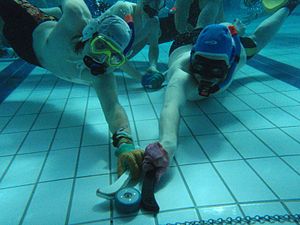Underwater hockey

Two players competing for the puck at GB Student Nationals, Bangor in 2009.
|
|
| Highest governing body | CMAS and WAA |
|---|---|
| Nicknames | UWH, Octopush |
| First played | 1954, Southsea, England |
| Characteristics | |
| Contact | limited |
| Team members | up to 10 (6 in play) |
| Mixed gender | Yes |
| Type | Aquatic |
| Equipment | diving mask, snorkel, fins, water polo cap, stick & puck. |
| Venue | Swimming pool |
| Presence | |
| Olympic | no |
| Paralympic | no |
Underwater Hockey (UWH), also known as Octopush (mainly in the United Kingdom) is a globally played limited-contact sport in which two teams compete to manoeuvre a puck across the bottom of a swimming pool into the opposing team's goal by propelling it with a hockey stick (bat). It originated in England in 1954 when Alan Blake, the founder of the newly formed Southsea Sub-Aqua Club, invented the game he called Octopush as a means of keeping the club's members interested and active over the cold winter months when open-water diving lost its appeal. Underwater Hockey is now played worldwide, with the Confédération Mondiale des Activités Subaquatiques, abbreviated CMAS, as the world governing body. The first Underwater Hockey World Championship was held in Canada in 1980 after a false start in 1979 brought about by international politics and apartheid.
Two teams of up to ten players compete, with six players in each team in play at any one time. The remaining four players are continually substituted into play from a substitution area, which may be on deck or in the water outside the playing area, depending on tournament rules.
Before the start of play the puck is placed in the middle of the pool, and the players wait in the water whilst touching the wall above the goal they are defending. At the start-of-play signal (usually a buzzer or a gong) in-play members of both teams are free to swim anywhere in the play area and try to score by manoeuvring the puck into the opponents' goal. Players hold their breath as they dive to the bottom of the pool (a form of dynamic apnoea, as in free-diving). Play continues until either a goal is scored, when players return to their wall to start a new point, or a break in play is signalled by a referee (whether due to a foul, a time-out, or the end of the period of play).
...
Wikipedia
